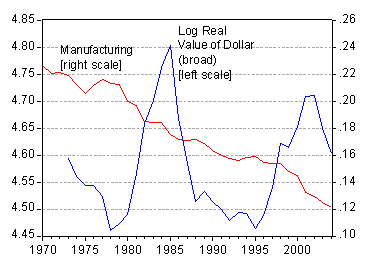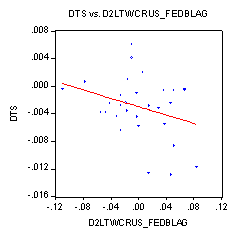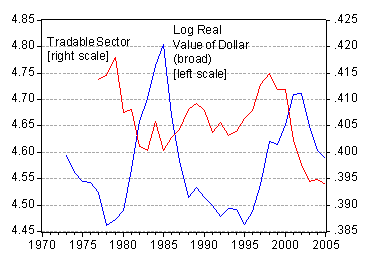Manufacturing employment is down. So is the manufacturing share of output. And so is the estimated tradable share of output. Consequently, as the Economist noted recently, adjustment to a smaller current account deficit might be difficult.
Last November, I wrote on why I thought manufacturing mattered — it matters not because of any intrinsic aspects associated with the manufacturing process, but the fact that manufacturing output appeared to be highly tradable. As of a ten months ago, employment had fallen, and not recovered to pre-recession levels. Many readers observed, however, that this dive in employment took place against a backdrop of rapid productivity growth. Hence, in Figure 1, I present and updated picture manufacturing employment and manufacturing labor productivity.

Figure 1: Manufacturing sector employment, in thousands (blue line), and log manufacturing output per man hour (red line), seasonally adjusted. Source: BLS via St. Louis Fed FREDII.
Given the rapid productivity growth in recent years, it’s possible that manufacturing output remained constant despite the fall off in employment. Indeed, nominal manufacturing sector value added has increased since 2001. But as a share of GDP, it’s fallen. Related to Brad Setser’s recent post, the share has been influenced by the real value of the dollar (see also Martin Baily’s PPT presentation).

Figure 2: Manufacturing sector value added as a share of GDP (red line) and real value of the dollar (broad) (blue line). Source: BEA Annual Industry Accounts, Federal Reserve via St. Louis Fed FREDII, and author’s calculations.
There is a negative relationship between the change in the manufacturing share of output and the annualized two year change the value of the dollar — strengthening of the dollar induces a shift of production toward non-manufacturing.

Figure 3: Change in Manufacturing sector value added as a share of GDP and lagged annualized two year change in the real value of the dollar (broad), and regression line (red). Source: BEA Annual Industry Accounts, Federal Reserve via St. Louis Fed FREDII, and author’s calculations.
An argument could be made that the tradable sector of the economy — what will be involved in the adjustment of the US economy to fewer imports and more exports — is much larger than just manufacturing. Hence, in addition to adding in the traditional “traded” sectors of mining (ex. oil) and agriculture, I add in professional and technical services, as well as 70% of financial services. The latter two components are added in following econometric work reported in Kletzer and Jensen [pdf].

Figure 4: Value added in manufacturing, mining (ex. oil), agriculture, professional and technical services, and 70% of finance, as a share of GDP (red line) and real value of the dollar (broad) (blue line). Source: BEA Annual Industry Accounts, Federal Reserve via St. Louis Fed FREDII, and author’s calculations. 2005 mining ex. oil value added estimate based on regression of 2000-2004 value added on index of mineral commodity prices, from April 2005 WEO.
Using this broader definition of the tradable sector, it appears that since 2000, the tradable sector has shrunk by over 1.5 percentage points of GDP, compared to the 2.5 percentage points when considering the manufacturing sector as the only tradables.
Note that despite the more moderate shrinkage, there is still a negative (and statistically significant) relationship between the share of tradables production and the real value of the dollar (in changes). My view is that expansionary fiscal policies (tax cuts that supported consumer investment in housing, spending biased toward non-tradables) induced a terms of trade shift against tradables, in addition to putting upward pressure on the dollar, thereby causing a reduction in the tradables share of output. Here’s the dollar’s impact on this measure of tradable output.

Figure 5: Change in tradable sector value added as a share of GDP and lagged annualized two year change in the real value of the dollar (broad), and regression line (red). Source: BEA Annual Industry Accounts, Federal Reserve via St. Louis Fed FREDII, and author’s calculations.
What is the true tradable share of GDP? It’s probably somewhere between the two (12 percentage points or 39.5 percentage points, in 2005).
Here’s the policy implication: If one needs to get the trade deficit to GDP deficit down from the 6 percentage points recorded in 2006q2 to say 2 percentage points, the implied 4 percentage points of adjustment will have to take place over either 12 or 39.5 percentage points worth of value added. We had better hope that the tradable share of GDP is closer to the 39.5 ppts., or that there is going to be a lot of labor that will be freed up from construction and nontradable services that can easily be reallocated to manufacturing, mining and tradable services with relatively low adjustment costs (realtors as computer code-writers!). The adjustment will be harder if rest-of-world demand (knzn’s hope for defense against a recession) doesn’t pick up the slack of declining US absorption.
In other words, those who said we should import and borrow as much as possible while prices of imports and interest rates were low were implicitly assuming the adjustment costs of reallocating resources across sectors were also low. Time will tell if they were right.
Technorati Tags: tradability,
dollar’s value,
manufacturing.
realtors as computer code-writers!
Not that difficult as many computer code-writers became realtors after the last recession.
IIRC Brad Delong had a post saying the same thing: There would have to be a large realocation of labor to balance the current trade inbalances.
I hope it ends in a softer landing.
Catching my eye: morning A through Z
Here’s what’s caught my eye this morning:
Marc Schulman of American Future is without question the finest news aggregator in the blogosphere. Check out this post on the British airline terror plot.
Bill Roggio of Counterterrorism Blog …
If manufacturing requires oil, then balancing the debt will be even harder because we will have to pay for the oil imports as well.
Making the numbers balance gets harder each day. Motor company exprts will decline. Imports of oil will increase.
Anybody who looks at the BEA numbers can see that the automobile is killing the US.
My question is, have we configured ourselves such that the marginal costs of increased production are greater than the marginal gains?
Menzie — just wanted to compliment you on this post. it is excellent.
Lord: Interesting point. Do you have some statistics. Also, we know that human capital depreciates, so adjustment may not be that easy, if workers are returning to a sector they came from.
Vorpal: I agree that exporting via manufactures probably requires additional oil consumption. But some of that oil consumption will be redirected from other (nontradables) uses, some will come from conservation, and some may come in the form of additional imports. To the extent that manufactures incorporates a lot of value added, that tradeoff may make sense.
dilbert dogbert: I agree — we should hope for a soft landing. In any case, if the Administration had any thought of easing the pain of adjustment, and rebuilding the consensus for free trade, it would greatly expand the trade adjustment assistance program. I am not aware of this being the case, however.
brad setser: Compliment accepted — always good to have one’s work appreciated.
No statistics, just anedotal experience. Still, you should see how many come out of the woodwork for a job fair.